A critical analysis of knowledge gaps in hand hygiene among nursing professionals
VerifiedAdded on 2023/06/03
|10
|2611
|471
AI Summary
This paper critically analyzes the knowledge gaps in hand hygiene among nursing professionals and their compliance with hand hygiene protocols. The analysis is based on three literary articles and aims to identify gaps in knowledge that prevent optimal implementation of hand hygiene protocol. The main findings suggest that lack of proper knowledge, unavailability of resources, and lack of proper training are the main reasons underlying lack of proper compliance of hand hygiene among the nursing professionals under the hospital settings.
Contribute Materials
Your contribution can guide someone’s learning journey. Share your
documents today.
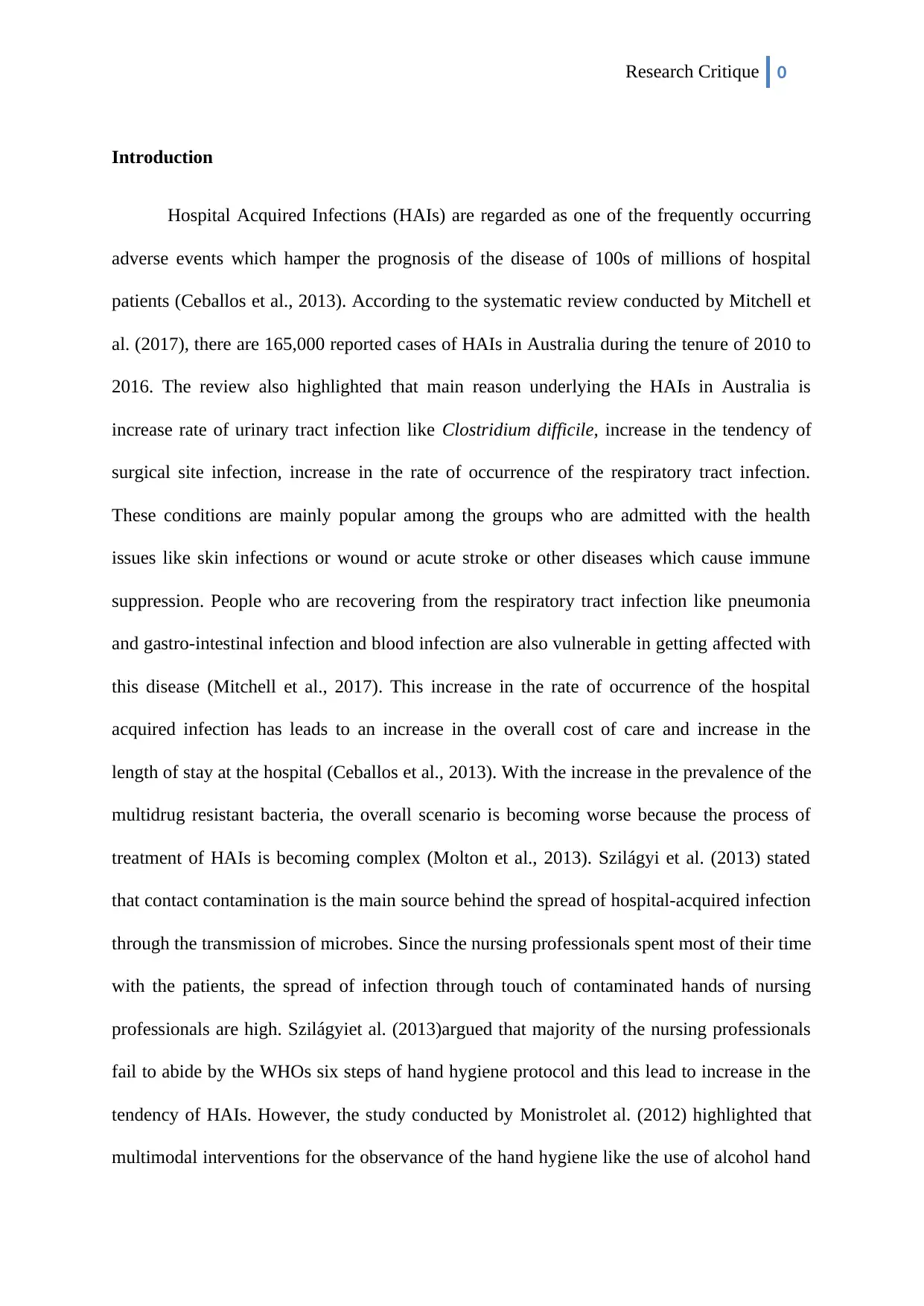
Research Critique 0
Introduction
Hospital Acquired Infections (HAIs) are regarded as one of the frequently occurring
adverse events which hamper the prognosis of the disease of 100s of millions of hospital
patients (Ceballos et al., 2013). According to the systematic review conducted by Mitchell et
al. (2017), there are 165,000 reported cases of HAIs in Australia during the tenure of 2010 to
2016. The review also highlighted that main reason underlying the HAIs in Australia is
increase rate of urinary tract infection like Clostridium difficile, increase in the tendency of
surgical site infection, increase in the rate of occurrence of the respiratory tract infection.
These conditions are mainly popular among the groups who are admitted with the health
issues like skin infections or wound or acute stroke or other diseases which cause immune
suppression. People who are recovering from the respiratory tract infection like pneumonia
and gastro-intestinal infection and blood infection are also vulnerable in getting affected with
this disease (Mitchell et al., 2017). This increase in the rate of occurrence of the hospital
acquired infection has leads to an increase in the overall cost of care and increase in the
length of stay at the hospital (Ceballos et al., 2013). With the increase in the prevalence of the
multidrug resistant bacteria, the overall scenario is becoming worse because the process of
treatment of HAIs is becoming complex (Molton et al., 2013). Szilágyi et al. (2013) stated
that contact contamination is the main source behind the spread of hospital-acquired infection
through the transmission of microbes. Since the nursing professionals spent most of their time
with the patients, the spread of infection through touch of contaminated hands of nursing
professionals are high. Szilágyiet al. (2013)argued that majority of the nursing professionals
fail to abide by the WHOs six steps of hand hygiene protocol and this lead to increase in the
tendency of HAIs. However, the study conducted by Monistrolet al. (2012) highlighted that
multimodal interventions for the observance of the hand hygiene like the use of alcohol hand
Introduction
Hospital Acquired Infections (HAIs) are regarded as one of the frequently occurring
adverse events which hamper the prognosis of the disease of 100s of millions of hospital
patients (Ceballos et al., 2013). According to the systematic review conducted by Mitchell et
al. (2017), there are 165,000 reported cases of HAIs in Australia during the tenure of 2010 to
2016. The review also highlighted that main reason underlying the HAIs in Australia is
increase rate of urinary tract infection like Clostridium difficile, increase in the tendency of
surgical site infection, increase in the rate of occurrence of the respiratory tract infection.
These conditions are mainly popular among the groups who are admitted with the health
issues like skin infections or wound or acute stroke or other diseases which cause immune
suppression. People who are recovering from the respiratory tract infection like pneumonia
and gastro-intestinal infection and blood infection are also vulnerable in getting affected with
this disease (Mitchell et al., 2017). This increase in the rate of occurrence of the hospital
acquired infection has leads to an increase in the overall cost of care and increase in the
length of stay at the hospital (Ceballos et al., 2013). With the increase in the prevalence of the
multidrug resistant bacteria, the overall scenario is becoming worse because the process of
treatment of HAIs is becoming complex (Molton et al., 2013). Szilágyi et al. (2013) stated
that contact contamination is the main source behind the spread of hospital-acquired infection
through the transmission of microbes. Since the nursing professionals spent most of their time
with the patients, the spread of infection through touch of contaminated hands of nursing
professionals are high. Szilágyiet al. (2013)argued that majority of the nursing professionals
fail to abide by the WHOs six steps of hand hygiene protocol and this lead to increase in the
tendency of HAIs. However, the study conducted by Monistrolet al. (2012) highlighted that
multimodal interventions for the observance of the hand hygiene like the use of alcohol hand
Secure Best Marks with AI Grader
Need help grading? Try our AI Grader for instant feedback on your assignments.
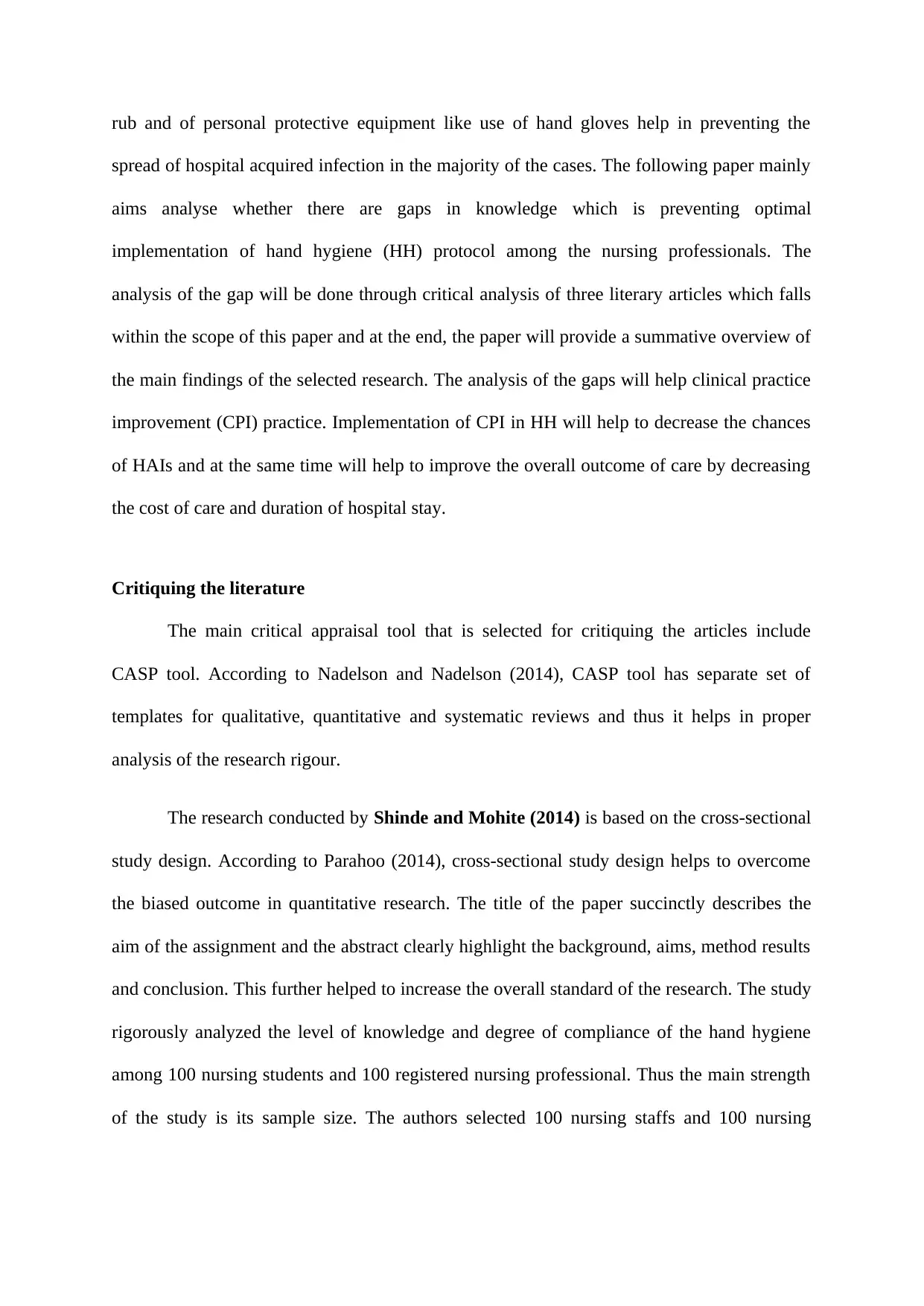
rub and of personal protective equipment like use of hand gloves help in preventing the
spread of hospital acquired infection in the majority of the cases. The following paper mainly
aims analyse whether there are gaps in knowledge which is preventing optimal
implementation of hand hygiene (HH) protocol among the nursing professionals. The
analysis of the gap will be done through critical analysis of three literary articles which falls
within the scope of this paper and at the end, the paper will provide a summative overview of
the main findings of the selected research. The analysis of the gaps will help clinical practice
improvement (CPI) practice. Implementation of CPI in HH will help to decrease the chances
of HAIs and at the same time will help to improve the overall outcome of care by decreasing
the cost of care and duration of hospital stay.
Critiquing the literature
The main critical appraisal tool that is selected for critiquing the articles include
CASP tool. According to Nadelson and Nadelson (2014), CASP tool has separate set of
templates for qualitative, quantitative and systematic reviews and thus it helps in proper
analysis of the research rigour.
The research conducted by Shinde and Mohite (2014) is based on the cross-sectional
study design. According to Parahoo (2014), cross-sectional study design helps to overcome
the biased outcome in quantitative research. The title of the paper succinctly describes the
aim of the assignment and the abstract clearly highlight the background, aims, method results
and conclusion. This further helped to increase the overall standard of the research. The study
rigorously analyzed the level of knowledge and degree of compliance of the hand hygiene
among 100 nursing students and 100 registered nursing professional. Thus the main strength
of the study is its sample size. The authors selected 100 nursing staffs and 100 nursing
spread of hospital acquired infection in the majority of the cases. The following paper mainly
aims analyse whether there are gaps in knowledge which is preventing optimal
implementation of hand hygiene (HH) protocol among the nursing professionals. The
analysis of the gap will be done through critical analysis of three literary articles which falls
within the scope of this paper and at the end, the paper will provide a summative overview of
the main findings of the selected research. The analysis of the gaps will help clinical practice
improvement (CPI) practice. Implementation of CPI in HH will help to decrease the chances
of HAIs and at the same time will help to improve the overall outcome of care by decreasing
the cost of care and duration of hospital stay.
Critiquing the literature
The main critical appraisal tool that is selected for critiquing the articles include
CASP tool. According to Nadelson and Nadelson (2014), CASP tool has separate set of
templates for qualitative, quantitative and systematic reviews and thus it helps in proper
analysis of the research rigour.
The research conducted by Shinde and Mohite (2014) is based on the cross-sectional
study design. According to Parahoo (2014), cross-sectional study design helps to overcome
the biased outcome in quantitative research. The title of the paper succinctly describes the
aim of the assignment and the abstract clearly highlight the background, aims, method results
and conclusion. This further helped to increase the overall standard of the research. The study
rigorously analyzed the level of knowledge and degree of compliance of the hand hygiene
among 100 nursing students and 100 registered nursing professional. Thus the main strength
of the study is its sample size. The authors selected 100 nursing staffs and 100 nursing
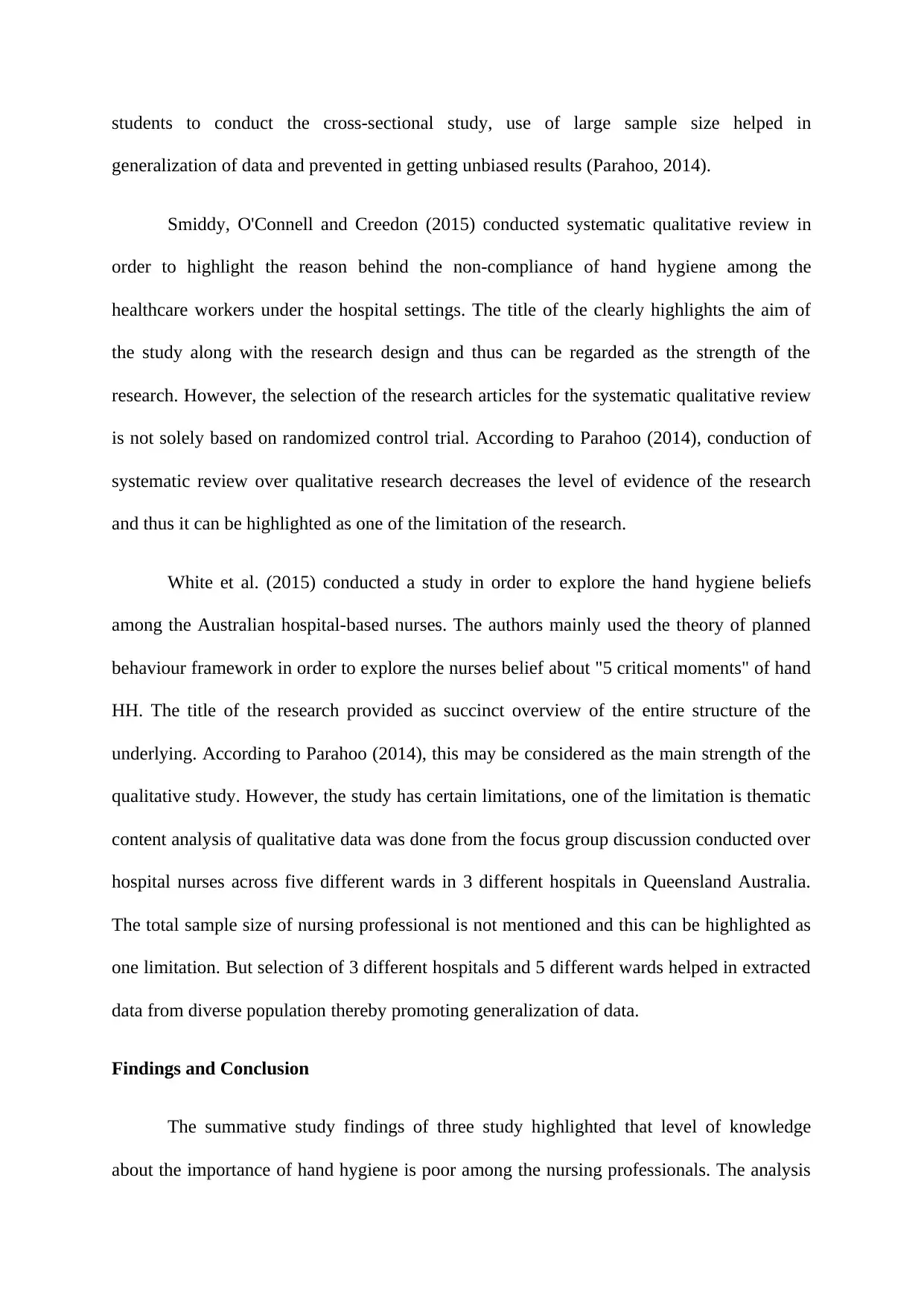
students to conduct the cross-sectional study, use of large sample size helped in
generalization of data and prevented in getting unbiased results (Parahoo, 2014).
Smiddy, O'Connell and Creedon (2015) conducted systematic qualitative review in
order to highlight the reason behind the non-compliance of hand hygiene among the
healthcare workers under the hospital settings. The title of the clearly highlights the aim of
the study along with the research design and thus can be regarded as the strength of the
research. However, the selection of the research articles for the systematic qualitative review
is not solely based on randomized control trial. According to Parahoo (2014), conduction of
systematic review over qualitative research decreases the level of evidence of the research
and thus it can be highlighted as one of the limitation of the research.
White et al. (2015) conducted a study in order to explore the hand hygiene beliefs
among the Australian hospital-based nurses. The authors mainly used the theory of planned
behaviour framework in order to explore the nurses belief about "5 critical moments" of hand
HH. The title of the research provided as succinct overview of the entire structure of the
underlying. According to Parahoo (2014), this may be considered as the main strength of the
qualitative study. However, the study has certain limitations, one of the limitation is thematic
content analysis of qualitative data was done from the focus group discussion conducted over
hospital nurses across five different wards in 3 different hospitals in Queensland Australia.
The total sample size of nursing professional is not mentioned and this can be highlighted as
one limitation. But selection of 3 different hospitals and 5 different wards helped in extracted
data from diverse population thereby promoting generalization of data.
Findings and Conclusion
The summative study findings of three study highlighted that level of knowledge
about the importance of hand hygiene is poor among the nursing professionals. The analysis
generalization of data and prevented in getting unbiased results (Parahoo, 2014).
Smiddy, O'Connell and Creedon (2015) conducted systematic qualitative review in
order to highlight the reason behind the non-compliance of hand hygiene among the
healthcare workers under the hospital settings. The title of the clearly highlights the aim of
the study along with the research design and thus can be regarded as the strength of the
research. However, the selection of the research articles for the systematic qualitative review
is not solely based on randomized control trial. According to Parahoo (2014), conduction of
systematic review over qualitative research decreases the level of evidence of the research
and thus it can be highlighted as one of the limitation of the research.
White et al. (2015) conducted a study in order to explore the hand hygiene beliefs
among the Australian hospital-based nurses. The authors mainly used the theory of planned
behaviour framework in order to explore the nurses belief about "5 critical moments" of hand
HH. The title of the research provided as succinct overview of the entire structure of the
underlying. According to Parahoo (2014), this may be considered as the main strength of the
qualitative study. However, the study has certain limitations, one of the limitation is thematic
content analysis of qualitative data was done from the focus group discussion conducted over
hospital nurses across five different wards in 3 different hospitals in Queensland Australia.
The total sample size of nursing professional is not mentioned and this can be highlighted as
one limitation. But selection of 3 different hospitals and 5 different wards helped in extracted
data from diverse population thereby promoting generalization of data.
Findings and Conclusion
The summative study findings of three study highlighted that level of knowledge
about the importance of hand hygiene is poor among the nursing professionals. The analysis
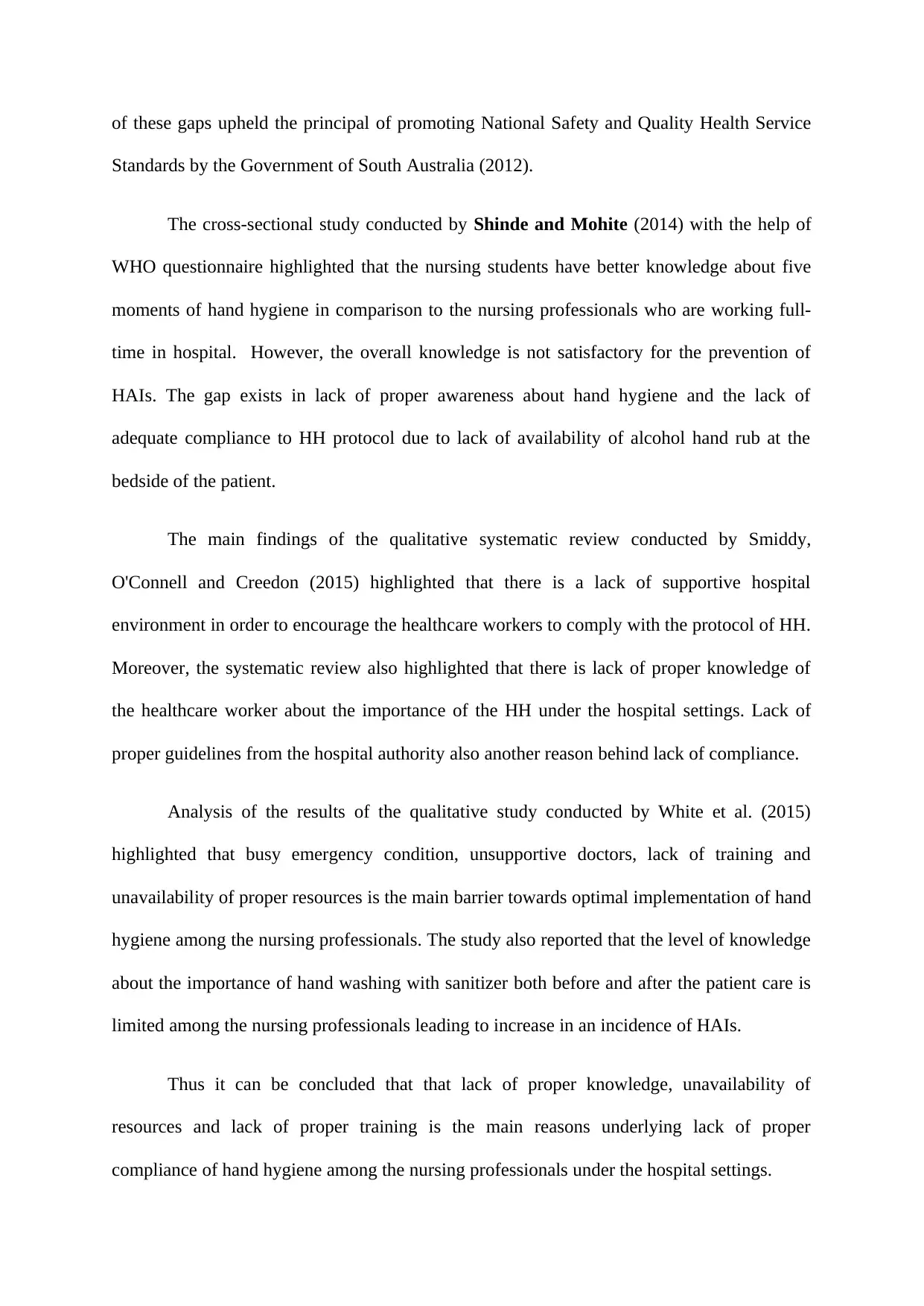
of these gaps upheld the principal of promoting National Safety and Quality Health Service
Standards by the Government of South Australia (2012).
The cross-sectional study conducted by Shinde and Mohite (2014) with the help of
WHO questionnaire highlighted that the nursing students have better knowledge about five
moments of hand hygiene in comparison to the nursing professionals who are working full-
time in hospital. However, the overall knowledge is not satisfactory for the prevention of
HAIs. The gap exists in lack of proper awareness about hand hygiene and the lack of
adequate compliance to HH protocol due to lack of availability of alcohol hand rub at the
bedside of the patient.
The main findings of the qualitative systematic review conducted by Smiddy,
O'Connell and Creedon (2015) highlighted that there is a lack of supportive hospital
environment in order to encourage the healthcare workers to comply with the protocol of HH.
Moreover, the systematic review also highlighted that there is lack of proper knowledge of
the healthcare worker about the importance of the HH under the hospital settings. Lack of
proper guidelines from the hospital authority also another reason behind lack of compliance.
Analysis of the results of the qualitative study conducted by White et al. (2015)
highlighted that busy emergency condition, unsupportive doctors, lack of training and
unavailability of proper resources is the main barrier towards optimal implementation of hand
hygiene among the nursing professionals. The study also reported that the level of knowledge
about the importance of hand washing with sanitizer both before and after the patient care is
limited among the nursing professionals leading to increase in an incidence of HAIs.
Thus it can be concluded that that lack of proper knowledge, unavailability of
resources and lack of proper training is the main reasons underlying lack of proper
compliance of hand hygiene among the nursing professionals under the hospital settings.
Standards by the Government of South Australia (2012).
The cross-sectional study conducted by Shinde and Mohite (2014) with the help of
WHO questionnaire highlighted that the nursing students have better knowledge about five
moments of hand hygiene in comparison to the nursing professionals who are working full-
time in hospital. However, the overall knowledge is not satisfactory for the prevention of
HAIs. The gap exists in lack of proper awareness about hand hygiene and the lack of
adequate compliance to HH protocol due to lack of availability of alcohol hand rub at the
bedside of the patient.
The main findings of the qualitative systematic review conducted by Smiddy,
O'Connell and Creedon (2015) highlighted that there is a lack of supportive hospital
environment in order to encourage the healthcare workers to comply with the protocol of HH.
Moreover, the systematic review also highlighted that there is lack of proper knowledge of
the healthcare worker about the importance of the HH under the hospital settings. Lack of
proper guidelines from the hospital authority also another reason behind lack of compliance.
Analysis of the results of the qualitative study conducted by White et al. (2015)
highlighted that busy emergency condition, unsupportive doctors, lack of training and
unavailability of proper resources is the main barrier towards optimal implementation of hand
hygiene among the nursing professionals. The study also reported that the level of knowledge
about the importance of hand washing with sanitizer both before and after the patient care is
limited among the nursing professionals leading to increase in an incidence of HAIs.
Thus it can be concluded that that lack of proper knowledge, unavailability of
resources and lack of proper training is the main reasons underlying lack of proper
compliance of hand hygiene among the nursing professionals under the hospital settings.
Secure Best Marks with AI Grader
Need help grading? Try our AI Grader for instant feedback on your assignments.
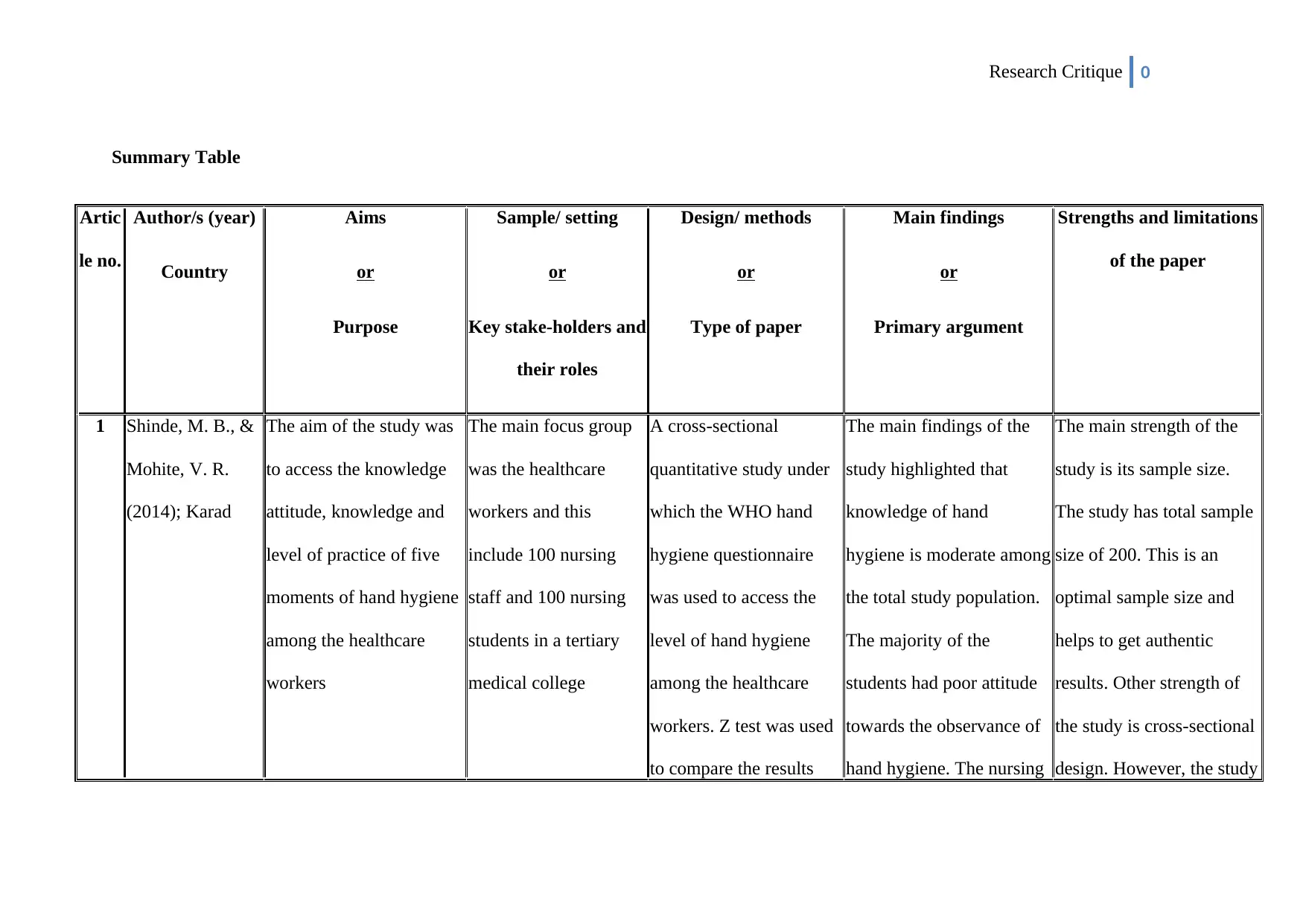
Research Critique 0
Summary Table
Artic
le no.
Author/s (year)
Country
Aims
or
Purpose
Sample/ setting
or
Key stake-holders and
their roles
Design/ methods
or
Type of paper
Main findings
or
Primary argument
Strengths and limitations
of the paper
1 Shinde, M. B., &
Mohite, V. R.
(2014); Karad
The aim of the study was
to access the knowledge
attitude, knowledge and
level of practice of five
moments of hand hygiene
among the healthcare
workers
The main focus group
was the healthcare
workers and this
include 100 nursing
staff and 100 nursing
students in a tertiary
medical college
A cross-sectional
quantitative study under
which the WHO hand
hygiene questionnaire
was used to access the
level of hand hygiene
among the healthcare
workers. Z test was used
to compare the results
The main findings of the
study highlighted that
knowledge of hand
hygiene is moderate among
the total study population.
The majority of the
students had poor attitude
towards the observance of
hand hygiene. The nursing
The main strength of the
study is its sample size.
The study has total sample
size of 200. This is an
optimal sample size and
helps to get authentic
results. Other strength of
the study is cross-sectional
design. However, the study
Summary Table
Artic
le no.
Author/s (year)
Country
Aims
or
Purpose
Sample/ setting
or
Key stake-holders and
their roles
Design/ methods
or
Type of paper
Main findings
or
Primary argument
Strengths and limitations
of the paper
1 Shinde, M. B., &
Mohite, V. R.
(2014); Karad
The aim of the study was
to access the knowledge
attitude, knowledge and
level of practice of five
moments of hand hygiene
among the healthcare
workers
The main focus group
was the healthcare
workers and this
include 100 nursing
staff and 100 nursing
students in a tertiary
medical college
A cross-sectional
quantitative study under
which the WHO hand
hygiene questionnaire
was used to access the
level of hand hygiene
among the healthcare
workers. Z test was used
to compare the results
The main findings of the
study highlighted that
knowledge of hand
hygiene is moderate among
the total study population.
The majority of the
students had poor attitude
towards the observance of
hand hygiene. The nursing
The main strength of the
study is its sample size.
The study has total sample
size of 200. This is an
optimal sample size and
helps to get authentic
results. Other strength of
the study is cross-sectional
design. However, the study
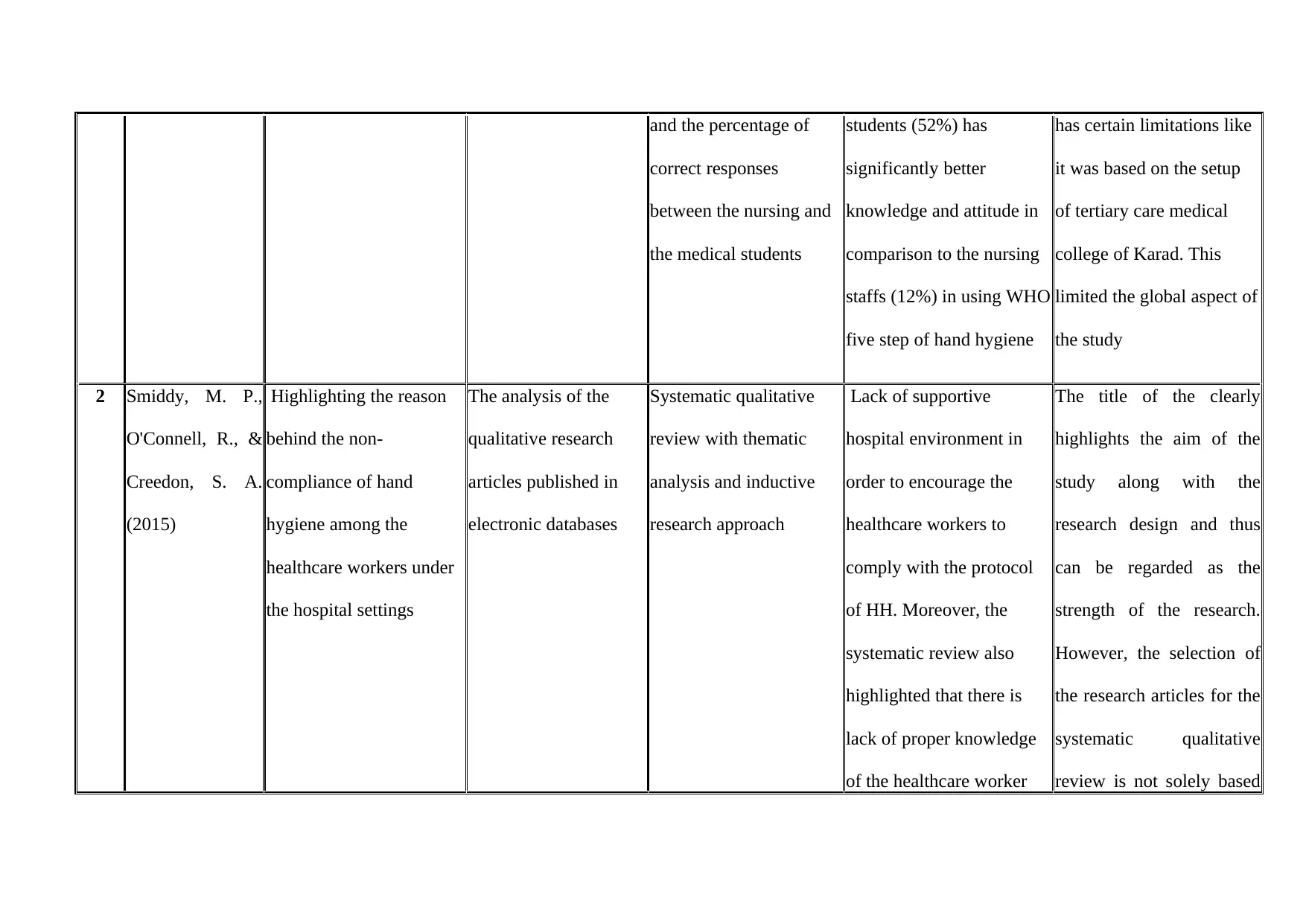
and the percentage of
correct responses
between the nursing and
the medical students
students (52%) has
significantly better
knowledge and attitude in
comparison to the nursing
staffs (12%) in using WHO
five step of hand hygiene
has certain limitations like
it was based on the setup
of tertiary care medical
college of Karad. This
limited the global aspect of
the study
2 Smiddy, M. P.,
O'Connell, R., &
Creedon, S. A.
(2015)
Highlighting the reason
behind the non-
compliance of hand
hygiene among the
healthcare workers under
the hospital settings
The analysis of the
qualitative research
articles published in
electronic databases
Systematic qualitative
review with thematic
analysis and inductive
research approach
Lack of supportive
hospital environment in
order to encourage the
healthcare workers to
comply with the protocol
of HH. Moreover, the
systematic review also
highlighted that there is
lack of proper knowledge
of the healthcare worker
The title of the clearly
highlights the aim of the
study along with the
research design and thus
can be regarded as the
strength of the research.
However, the selection of
the research articles for the
systematic qualitative
review is not solely based
correct responses
between the nursing and
the medical students
students (52%) has
significantly better
knowledge and attitude in
comparison to the nursing
staffs (12%) in using WHO
five step of hand hygiene
has certain limitations like
it was based on the setup
of tertiary care medical
college of Karad. This
limited the global aspect of
the study
2 Smiddy, M. P.,
O'Connell, R., &
Creedon, S. A.
(2015)
Highlighting the reason
behind the non-
compliance of hand
hygiene among the
healthcare workers under
the hospital settings
The analysis of the
qualitative research
articles published in
electronic databases
Systematic qualitative
review with thematic
analysis and inductive
research approach
Lack of supportive
hospital environment in
order to encourage the
healthcare workers to
comply with the protocol
of HH. Moreover, the
systematic review also
highlighted that there is
lack of proper knowledge
of the healthcare worker
The title of the clearly
highlights the aim of the
study along with the
research design and thus
can be regarded as the
strength of the research.
However, the selection of
the research articles for the
systematic qualitative
review is not solely based
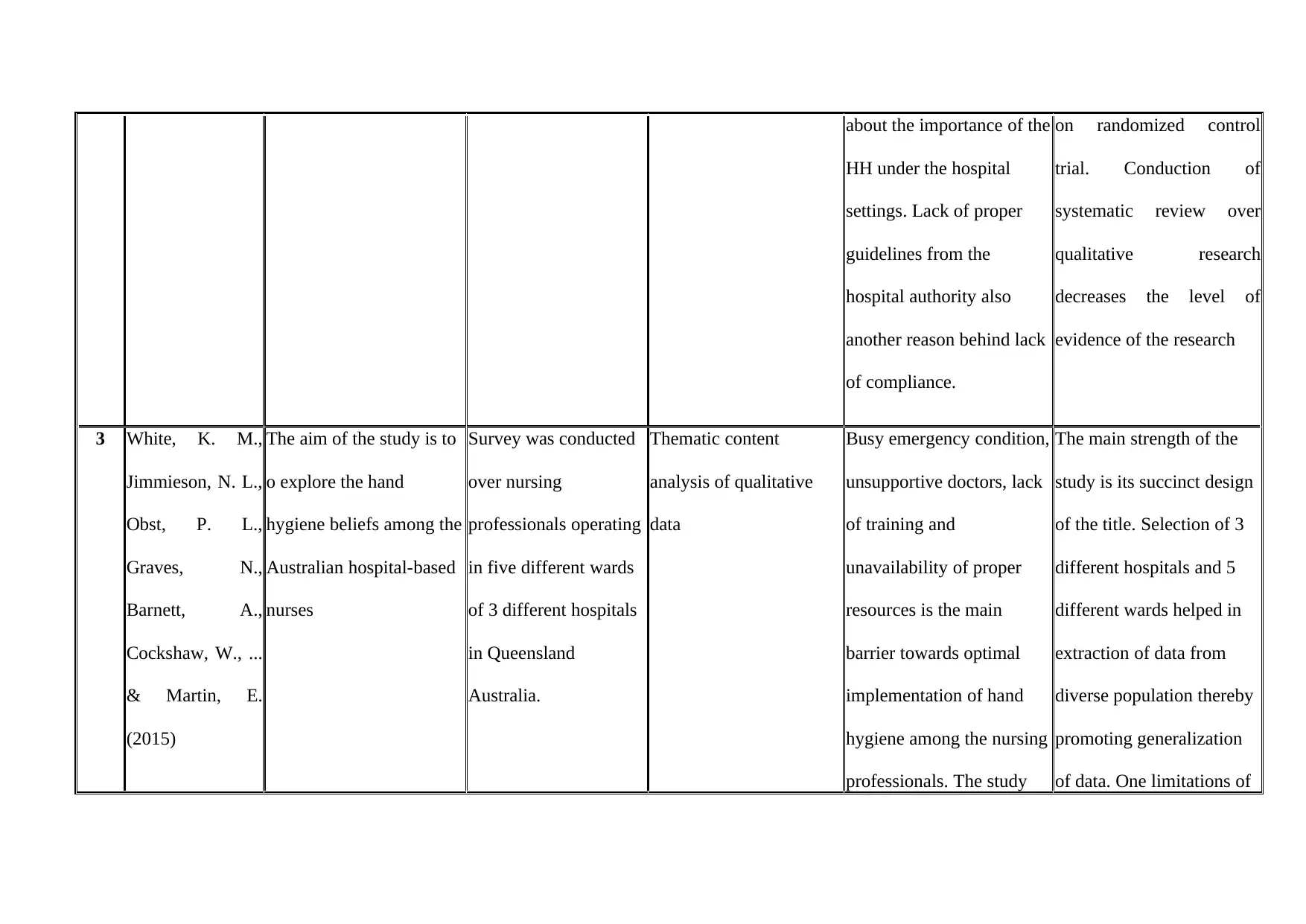
about the importance of the
HH under the hospital
settings. Lack of proper
guidelines from the
hospital authority also
another reason behind lack
of compliance.
on randomized control
trial. Conduction of
systematic review over
qualitative research
decreases the level of
evidence of the research
3 White, K. M.,
Jimmieson, N. L.,
Obst, P. L.,
Graves, N.,
Barnett, A.,
Cockshaw, W., ...
& Martin, E.
(2015)
The aim of the study is to
o explore the hand
hygiene beliefs among the
Australian hospital-based
nurses
Survey was conducted
over nursing
professionals operating
in five different wards
of 3 different hospitals
in Queensland
Australia.
Thematic content
analysis of qualitative
data
Busy emergency condition,
unsupportive doctors, lack
of training and
unavailability of proper
resources is the main
barrier towards optimal
implementation of hand
hygiene among the nursing
professionals. The study
The main strength of the
study is its succinct design
of the title. Selection of 3
different hospitals and 5
different wards helped in
extraction of data from
diverse population thereby
promoting generalization
of data. One limitations of
HH under the hospital
settings. Lack of proper
guidelines from the
hospital authority also
another reason behind lack
of compliance.
on randomized control
trial. Conduction of
systematic review over
qualitative research
decreases the level of
evidence of the research
3 White, K. M.,
Jimmieson, N. L.,
Obst, P. L.,
Graves, N.,
Barnett, A.,
Cockshaw, W., ...
& Martin, E.
(2015)
The aim of the study is to
o explore the hand
hygiene beliefs among the
Australian hospital-based
nurses
Survey was conducted
over nursing
professionals operating
in five different wards
of 3 different hospitals
in Queensland
Australia.
Thematic content
analysis of qualitative
data
Busy emergency condition,
unsupportive doctors, lack
of training and
unavailability of proper
resources is the main
barrier towards optimal
implementation of hand
hygiene among the nursing
professionals. The study
The main strength of the
study is its succinct design
of the title. Selection of 3
different hospitals and 5
different wards helped in
extraction of data from
diverse population thereby
promoting generalization
of data. One limitations of
Paraphrase This Document
Need a fresh take? Get an instant paraphrase of this document with our AI Paraphraser
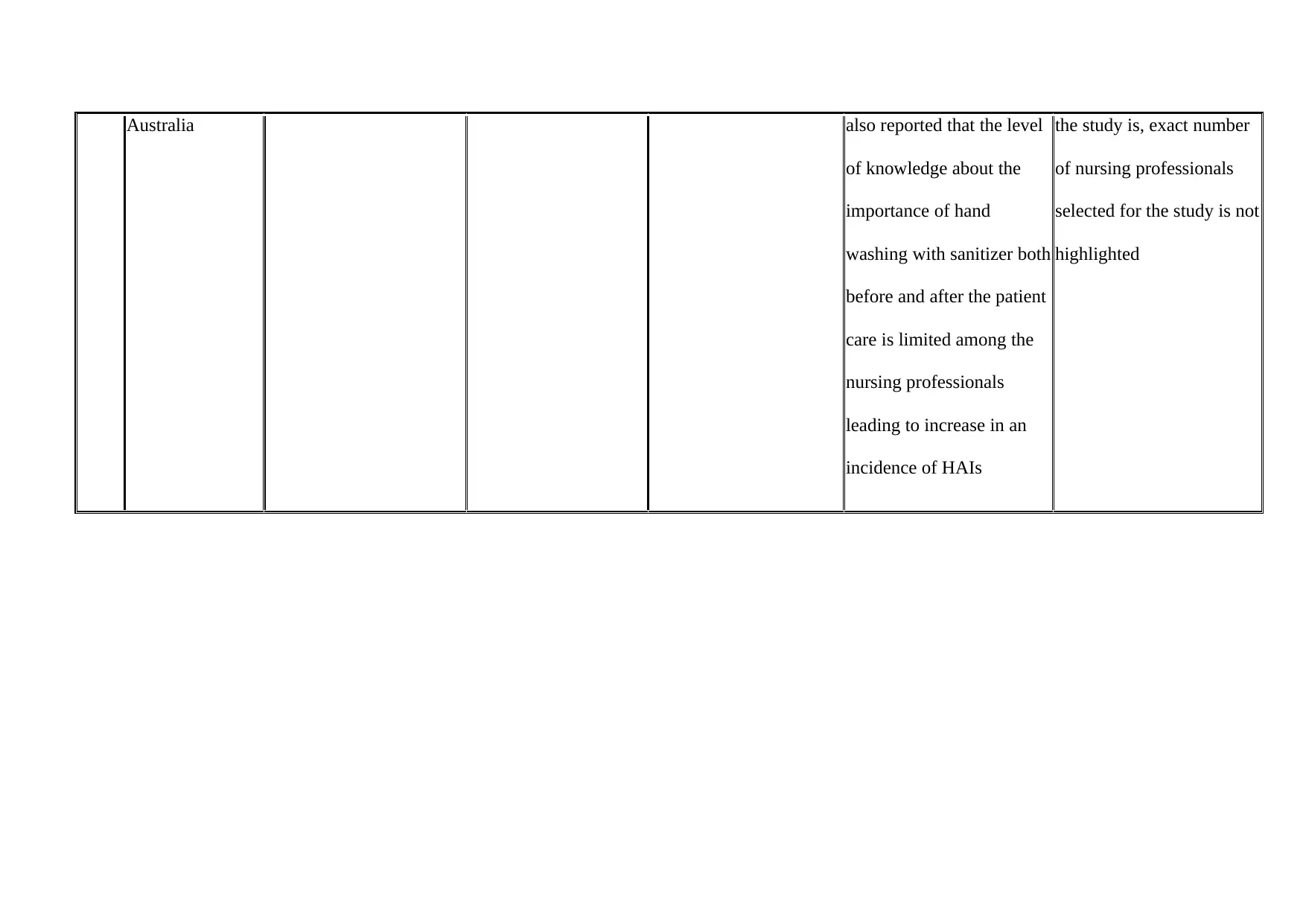
Australia also reported that the level
of knowledge about the
importance of hand
washing with sanitizer both
before and after the patient
care is limited among the
nursing professionals
leading to increase in an
incidence of HAIs
the study is, exact number
of nursing professionals
selected for the study is not
highlighted
of knowledge about the
importance of hand
washing with sanitizer both
before and after the patient
care is limited among the
nursing professionals
leading to increase in an
incidence of HAIs
the study is, exact number
of nursing professionals
selected for the study is not
highlighted

References
Australian Commission on Safety and Quality in Health Care (2012). National Safety and
Quality Health Service Standards. Access date: 16th November 2018. Retrieved from:
https://www.safetyandquality.gov.au/wp-content/uploads/2011/09/NSQHS-Standards-
Sept-2012.pdf
Ceballos, K., Waterman, K., Hulett, T., & Makic, M. B. F. (2013). Nurse-driven quality
improvement interventions to reduce hospital-acquired infection in the NICU. Advances
in Neonatal Care, 13(3), 154-163.
Mitchell, B. G., Shaban, R. Z., MacBeth, D., Wood, C. J., & Russo, P. L. (2017). The burden of
healthcare-associated infection in Australian hospitals: a systematic review of the
literature. Infection, Disease & Health, 22(3), 117-128.
Molton, J. S., Tambyah, P. A., Ang, B. S., Ling, M. L., & Fisher, D. A. (2013). The global
spread of healthcare-associated multidrug-resistant bacteria: a perspective from
Asia. Clinical Infectious diseases, 56(9), 1310-1318.
Monistrol, O., Calbo, E., Riera, M., Nicolás, C., Font, R., Freixas, N., &Garau, J. (2012). Impact
of a hand hygiene educational programme on hospital‐acquired infections in medical
wards. Clinical Microbiology and Infection, 18(12), 1212-1218.
Nadelson, S., &Nadelson, L. S. (2014). Evidence‐based practice article reviews using CASP
tools: a method for teaching EBP. Worldviews on Evidence‐Based Nursing, 11(5), 344-
346.
Australian Commission on Safety and Quality in Health Care (2012). National Safety and
Quality Health Service Standards. Access date: 16th November 2018. Retrieved from:
https://www.safetyandquality.gov.au/wp-content/uploads/2011/09/NSQHS-Standards-
Sept-2012.pdf
Ceballos, K., Waterman, K., Hulett, T., & Makic, M. B. F. (2013). Nurse-driven quality
improvement interventions to reduce hospital-acquired infection in the NICU. Advances
in Neonatal Care, 13(3), 154-163.
Mitchell, B. G., Shaban, R. Z., MacBeth, D., Wood, C. J., & Russo, P. L. (2017). The burden of
healthcare-associated infection in Australian hospitals: a systematic review of the
literature. Infection, Disease & Health, 22(3), 117-128.
Molton, J. S., Tambyah, P. A., Ang, B. S., Ling, M. L., & Fisher, D. A. (2013). The global
spread of healthcare-associated multidrug-resistant bacteria: a perspective from
Asia. Clinical Infectious diseases, 56(9), 1310-1318.
Monistrol, O., Calbo, E., Riera, M., Nicolás, C., Font, R., Freixas, N., &Garau, J. (2012). Impact
of a hand hygiene educational programme on hospital‐acquired infections in medical
wards. Clinical Microbiology and Infection, 18(12), 1212-1218.
Nadelson, S., &Nadelson, L. S. (2014). Evidence‐based practice article reviews using CASP
tools: a method for teaching EBP. Worldviews on Evidence‐Based Nursing, 11(5), 344-
346.

Shinde, M. B., & Mohite, V. R. (2014). A study to assess knowledge, attitude and practices of
five moments of hand hygiene among nursing staff and students at a tertiary care hospital
at Karad. International Journal of Science and Research, 3(2), 311-321.
Smiddy, M. P., O'Connell, R., & Creedon, S. A. (2015). Systematic qualitative literature review
of health care workers' compliance with hand hygiene guidelines. American Journal of
Infection Control, 43(3), 269-274.
Szilágyi, L., Haidegger, T., Lehotsky, Á., Nagy, M., Csonka, E. A., Sun, X., ... & Fisher, D.
(2013). A large-scale assessment of hand hygiene quality and the effectiveness of the
“WHO 6-steps”. BioMed Central Infectious Diseases, 13(1), 249.
White, K. M., Jimmieson, N. L., Obst, P. L., Graves, N., Barnett, A., Cockshaw, W., ... &
Martin, E. (2015). Using a theory of planned behaviour framework to explore hand
hygiene beliefs at the ‘5 critical moments’ among Australian hospital-based
nurses. BioMed Central Health Services Research, 15(1), 59.
five moments of hand hygiene among nursing staff and students at a tertiary care hospital
at Karad. International Journal of Science and Research, 3(2), 311-321.
Smiddy, M. P., O'Connell, R., & Creedon, S. A. (2015). Systematic qualitative literature review
of health care workers' compliance with hand hygiene guidelines. American Journal of
Infection Control, 43(3), 269-274.
Szilágyi, L., Haidegger, T., Lehotsky, Á., Nagy, M., Csonka, E. A., Sun, X., ... & Fisher, D.
(2013). A large-scale assessment of hand hygiene quality and the effectiveness of the
“WHO 6-steps”. BioMed Central Infectious Diseases, 13(1), 249.
White, K. M., Jimmieson, N. L., Obst, P. L., Graves, N., Barnett, A., Cockshaw, W., ... &
Martin, E. (2015). Using a theory of planned behaviour framework to explore hand
hygiene beliefs at the ‘5 critical moments’ among Australian hospital-based
nurses. BioMed Central Health Services Research, 15(1), 59.
1 out of 10
Related Documents
Your All-in-One AI-Powered Toolkit for Academic Success.
+13062052269
info@desklib.com
Available 24*7 on WhatsApp / Email
![[object Object]](/_next/static/media/star-bottom.7253800d.svg)
Unlock your academic potential
© 2024 | Zucol Services PVT LTD | All rights reserved.





